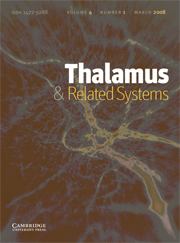Article contents
Thalamocortical connectivity in a rat brain slice preparation: participation of the ventrobasal complex to synchronous activities
Published online by Cambridge University Press: 12 April 2006
Abstract
We studied the synchronous cortical and thalamic activities induced by low (0.5–1 mM) and high (50–100 mM) concentrations of the K+ channel blocker 4-aminopyridine (4AP) in a rat thalamocortical preparation. The presence of reciprocal thalamocortical connectivity was documented by diffusion of the fluorescent tracer Di-IC18 between the somatosensory cortex and the ventrobasal complex (VB) of the thalamus in vitro. Functional reciprocal connectivity was also demonstrated by stimulating the cortical middle-deep layers (which elicited orthodromic responses in VB) or the VB (which induced orthodromic and antidromic responses in the cortex). Spontaneous field potentials were not recorded in either the thalamus or cortex in control medium. Low concentrations of 4AP produced local spindle-like rhythmic oscillations in cortex and VB (duration = 0.4–3.5 s; frequency = 9–16 Hz). In contrast, high concentrations of 4AP induced widespread ictal-like epileptiform discharges (duration = 8–45 s) characterised by lsquo ‘tonic’ component followed by a period of ‘clonic’ discharges in both cortex and VB. Spindle-like activity was abolished in cortex and thalamus by applying the excitatory amino acid receptor antagonist kynurenic acid in VB. In contrast, the same procedure exacerbated ictal-like discharges, while depressing VB activity. Our results indicate that thalamus and cortex can produce synchronous activities in this in vitro thalamocortical network: spindle-like rhythmic oscillations are generated at the thalamic level and imposed upon the cortical network whereas ictal-like discharges have a cortical origin and are modulated by the thalamic network activity. In addition, we have shown that it is possible to preserve reciprocal projections between cortex and thalamus in an in vitro rat slice preparation that could be a valuable tool to study epileptic-prone rat strains.
- Type
- Research Article
- Information
- Copyright
- 2001 Elsevier Science Ltd
- 1
- Cited by


